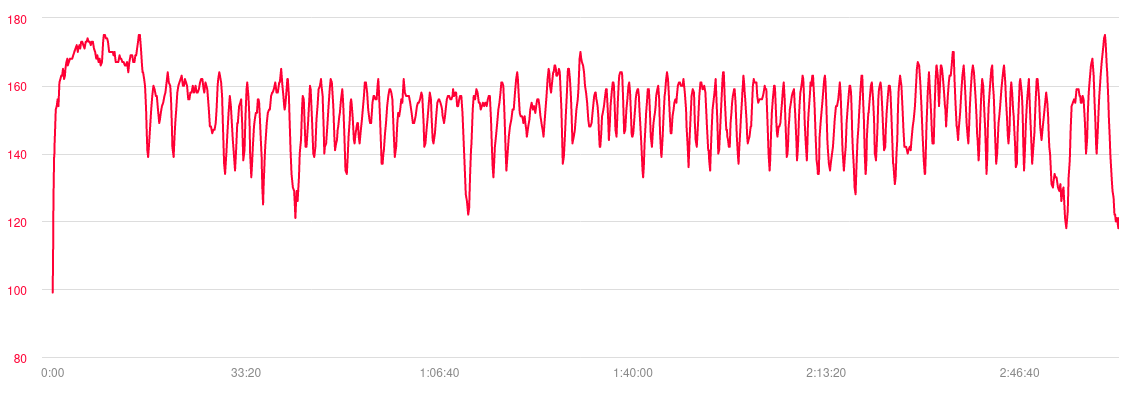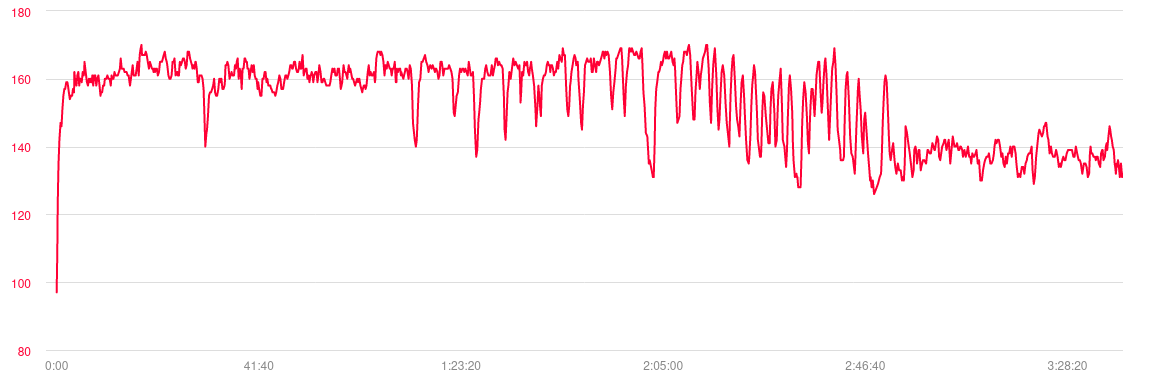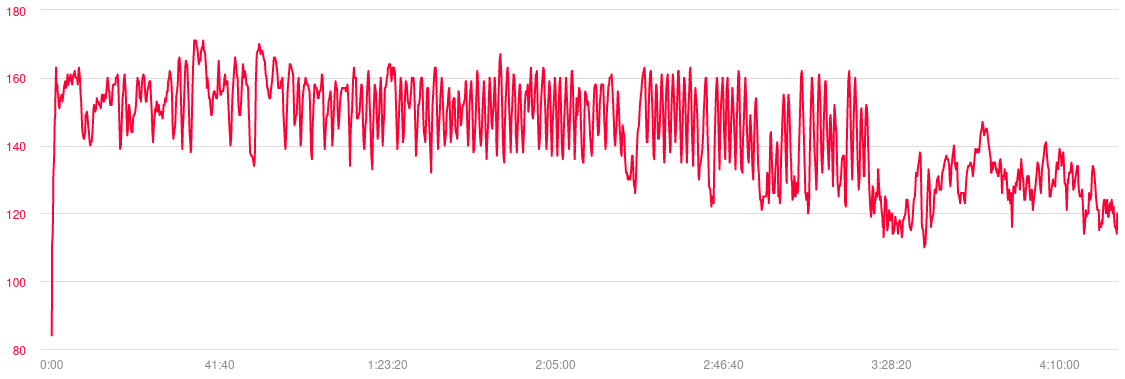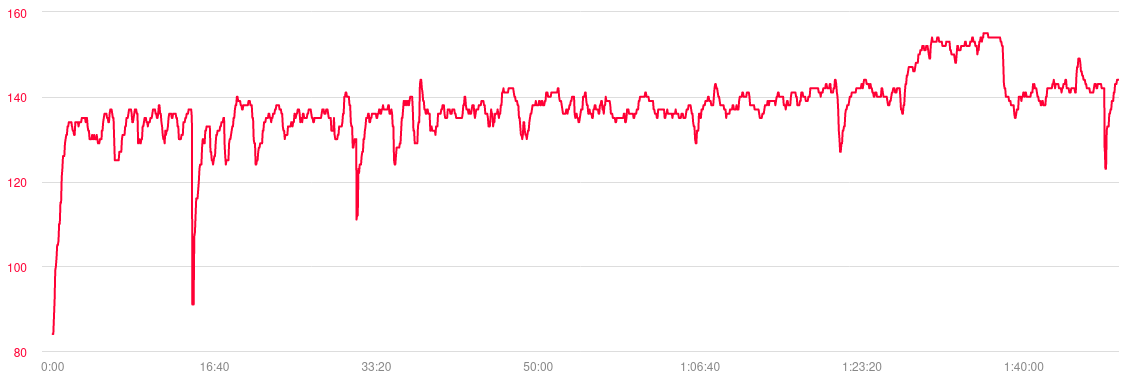In today’s example of “this is why I blog”: as I implement Zone 2 training for doing distance running again I was lamenting not having done so for my 2013 marathon training. According to my race recap post it turns out I did implement Zone 2 training. Well, I thought I had anyway. Looking back over the data however it is pretty clear that I did not. That’s not just a question of my race performance, where I threw all of that to the wind anyway, but also looking at the training data from that era as well.
Heart Rate Zone training is about running in one of five heart rate zones matched for the particular type of distance you are training for. The standard heart rate zones for the five step system are: Zone 1 (comfortable zone like walking), Zone 2 (low intensity exercise mostly burning fat for fuel), Zone 3 (typical running “aerobic zone” burning sugar and fat), Zone 4 (pretty intense zone burning mostly sugar for fuel) and Zone 5 (super high intensity zone, can’t be maintained for long periods of time). It’s a bit of an over-simplification but if you were training for sprints you would try to do much of your training running in the higher zones. If you are going for long distance running, like I am, you want to do most of your training in Zone 2 or Zone 3.
There are various programs that are available. Some say it should all be Zone 2. Some say that 80% of your training volume should be Zone 2. As with most things there are no hard and fast rules. Training in these lower zones help build up your cardio base by building up your mitochondria density (the powerhouses of the cells) . It’s not that training in other zones doesn’t provide benefit but for endurance running you really need this solid base and Zone 2 is a very efficient way to get there. Zone 2 is also a zone where much of the energy usage is coming from fat stores rather than sugar. We obviously have a lot of fat in our bodies, even if we are lean. We have relatively limited reserves of sugar though. As I learned from my marathon bonk it’s basically 2.5-3.5 hours worth. This means that we can run for much much longer in Zone 2 than we can in the higher zones.s
Calculating Zone 2 can be done in a number of ways. Back in the day I actually had tests done on treadmills with breathing masks and even a calibrated calculation by a cardiologist who also measured my maximum heart rate. My zones were kind of all over the place. They aren’t set in stone. They change as our fitness level changes and how our particular fitness level changes as well. Currently I’m using this calculator with the inputs being the maximum heart rate I’ve seen on intense runs and my calculated resting heart rate from wearing a fitness tracker 24/7. That currently calculates my Zone 2 range as between 126 and 140, and Zone 3 as between 140 and 154. Testing in the past has had lots of variation, even with measurements, but this sort of breakdown is within bounds.
I’ve been far more cautious about staying in Zone 2 now than I did in 2013. That’s a combination of having gotten my face cracked in the marathon when I hit the wall and the fact that I’m now pushing 50 rather than pushing 40. Not only is Zone 2 hypothetically the most efficient way to build up endurance base but the slower pace is also easier on the joints and the body over all. Being older I want the extra margin from these runs. I recall how beat up I felt as the long runs got every higher than 13 miles and I don’t want to repeat that experience.
Looking at the data with a bit more care than I did before I see that while I thought I was doing Zone 2 training back then it is clear that I was not. It should have been clear that I wasn’t back then too. I commented in my race recap that, “All of my long runs during training were done in Heart Rate Zone 2…Ideally I would have cranked my run intensity up from Zone 2 to Zone 3. I had downshifted my training zones to Zone 2 because I was constantly running out of steam part of the way through, more on that in a minute.” So we have some problem here. First, it wasn’t until way late in the training that I started doing anything like trying to do Zone 2 training. Before that I ran all my runs more in some combination of Zone 3 and 4. There is certainly cardiovascular benefit to running in those zones as well. But in terms of endurance training it wasn’t helping as much as staying in Zone 2 for most of the training would have. Looking back over the training then I can see where I stumbled.
First, like with many people’s trainings, my easy runs were almost never easy runs. If one is doing Zone 2 training, easy runs should definitely be Zone 2 runs. Mine were often much faster than that. I wasn’t doing sprints or anything, so I guess compared to my “hard run” days they were easier. But they weren’t truly easy. That’s a good bit of training that should be contributing to the the 80% Zone 2 percentage that wasn’t. Second, most of my long runs weren’t Zone 2 either. As I wrote back then it was only at the end of my training when I was hitting the wall on longer runs that I finally decided to start trying to make sure I was in Zone 2. That really meant only a handful of runs that I did that. Even in those I wasn’t really being good about staying in Zone 2 either.
From what I can tell the calculation I had at the time I should have kept my average heart rate between 136 and 150 to stay in Zone 2, and between 150 and 163 for Zone 3. The three last training runs, the truly long runs, were 16, 18, and 20 miles. For those my average heart rate were 152, 153, and 144, respectively. The first 16 and 18 mile runs were a little high but not egregiously so. The 20 mile run was spot on. At least that’s what the average says. What does the detailed heart rate data show however?

2013’s 16 Mile Run Heart Rate History

2013’s 18 Mile Run Heart Rate History

2013’s 20 Mile Run Heart Rate History
These are, to put it mildly, a hot mess. I don’t know why I looked at this data, which I am sure I did at the time, and said, “Yep this is Zone 2 training!” Zone 2 training means to stay mostly within Zone 2. That means that for back in the day I should be seeing my heart rate mostly between 136 and 150 bpm. What instead I have is a constant oscillation between 140 and 160 bpm until 2.5-3 hours in I hit the wall. That means that for most of the run I was at best dropping half way into Zone 2 on my walk breaks and then running up to the top of Zone 3 before starting the next walk break. The more I write about this the more I recall thinking that was the right thing to do as long as things averaged out in the end but that’s simply not true. Stating it was Zone 2 training doesn’t hold water. In the case of the 16 and 18 mile runs it was even worse! I actually ran the first part of those runs well into Zone 4 or the bottom of Zone 5! These runs are all then essentially burning through my glycogen stores most of the time. As I wrote above when in those higher zones we really only have a good 2.5-3.5 hours worth. You can see in the heart rate data, and even clearer in the pace data, that I was “hitting the wall” at exactly that point in these training runs. That should have been a big red flag that I was not doing Zone 2 training well at all.
So what should this look like if I were doing Zone 2 training well? For runs from this year where I’m trying much more religiously to stay in Zone 2 for runs we get something that looks much better. For example from today’s 9 mile run:

2024’s 9 Mile Run Heart Rate History
Here we see that for most of the runs the top end is about 140 bpm, the top of my current Zone 2 estimated zone. I did inadvertently let it creep a bit too much in the 1:15 to 1:25 interval. The problem is that I still have a pretty relaxed breathing rate at much higher heart rates. So the whole “can you breath through your nose for extended periods” or “can you carry on a conversation” are more than possible well above the top of my Zone 2. I therefore need to be a bit more cautious. The spike in the 1:28 to 1:38 was intentionally trying to run a 10 minute mile pace for the the penultimate mile. I had a lot of gas left in the tank and it was only two miles left in the entire training run. So I’m okay with that. However I do wish that I got my heart rate for the last mile down below 1400 for most of it.
I had previously attributed a lot of other things to my getting beat up on my long runs back in the 2013. I did almost no cross training back in the day. I was almost completely religious about my long runs, slightly less so about my “easy” run, and very inconsistent with my hard run each week. That really left me with often running once a week or at most twice. Combine that with a not bad but not great diet and work stress that was pretty high at the time and you have a recipe for a lot of problems. I’m sure that those were all complicating factors, especially the poor training consistency and lack of cross training. But even all that dialed in the fact is that I was not running in a sustainable way on these long runs.
The lessons learned from looking at this historical data and knowing what I know now hat I’m applying to my training this time around are:
- Do most of my mileage as Zone 2 training, with a true easy run in Zone 2.
- Long runs must be substantially Zone 2 throughout the run, especially from the beginning.
- Focus speed runinng work into one set of workouts on just one day with either Tempo Runs, Hill Runs, or 4x4x4 (4 sets of 4 minutes at hard pace followed by 4 minutes at easy pace)
- Doing substantial cross training including cycling, weight lifting, stretching, yoga, etc.
- Analyze whether the zone calculations are right based on how good I feel through the longer runs. If I’m bonking despite fueling then my heart rate zone estimates are too high and they need to be adjusted down accordingly.




 2024-03-03
in
2024-03-03
in

 9 min read
9 min read